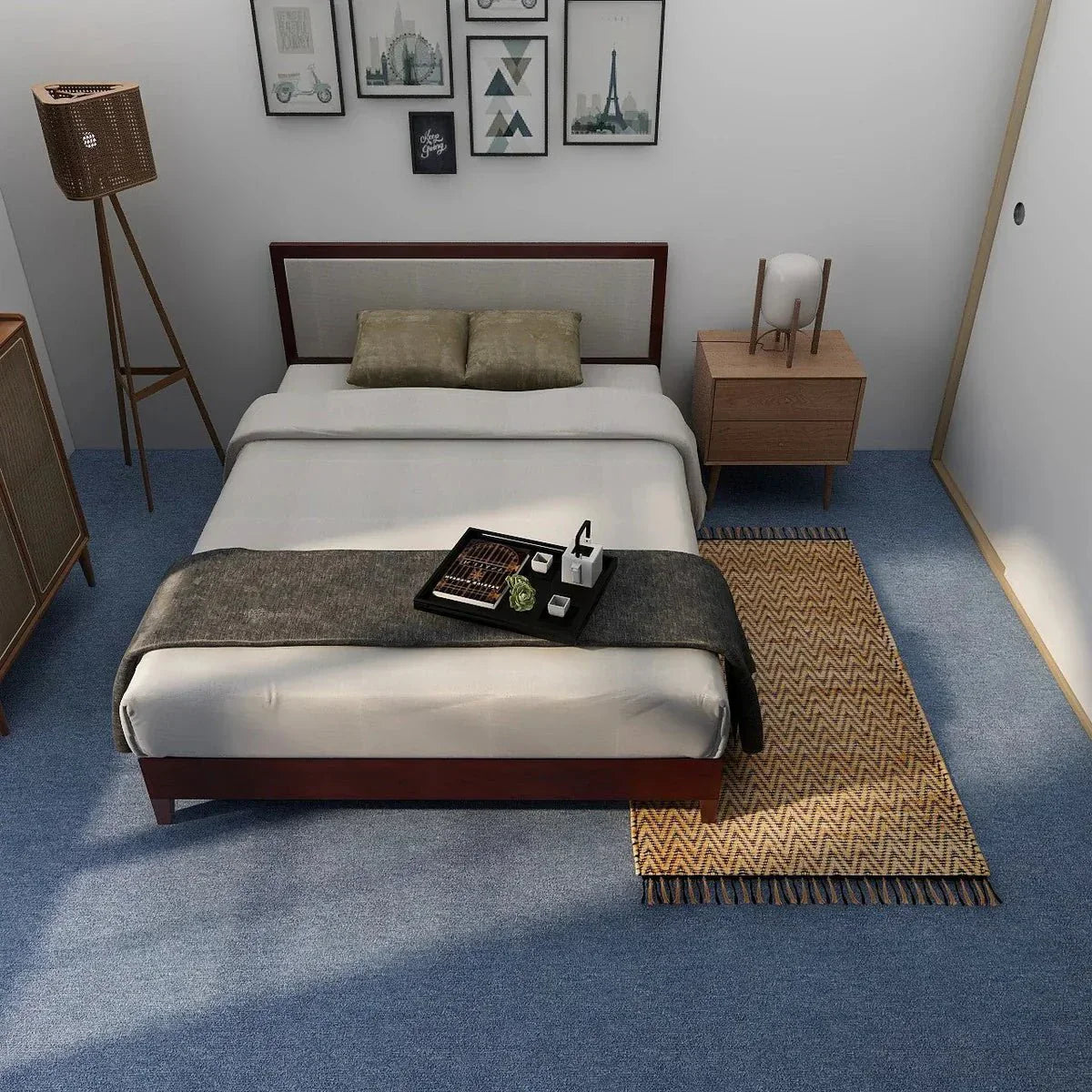
Are Jute Rugs Good for High Traffic Areas?
Key Takeaway:
- Jute rugs are durable for medium to high traffic.
- Best for entryways, hallways, and living rooms.
- Use rug pads and vacuum regularly for longer lifespan.
- Natural fiber rugs like jute offer a soft, earthy look.
- Not ideal for wet or humid areas.
Yes, jute rugs are suitable for many high traffic areas, especially if you prefer natural fiber rugs with a strong yet soft texture. Their durability and neutral look make them a favorite for living rooms, entryways, and hallways.
How Durable Are Jute Rugs in High Traffic Zones?
Jute rugs are made from tightly woven plant fibers. This gives them a solid, durable structure that can handle regular foot traffic. A jute rug's high traffic rating often depends on its weave. Flat-woven and low pile jute rugs last longer in busy areas.
Durability Comparison:
Jute offers moderate to high durability for high-traffic areas, though it tends to have low shedding and limited stain resistance.
Sisal stands out with high durability and low shedding, providing moderate resistance to stains.
Wool rugs are known for their very high durability and high stain resistance, though they shed moderately.
Polypropylene rugs top the list in both durability and stain resistance while exhibiting no shedding at all.
According to Good Housekeeping, natural fiber rugs like jute and sisal are among the top five most preferred materials for eco-conscious consumers seeking options for high-traffic home zones.
Why Are Jute Rugs a Good Choice for Living Rooms and Hallways?
Jute rugs are soft underfoot and visually warm. Their earthy tones complement most interior designs. Many people choose jute rugs living room styles that are low pile and flat-woven. For hallway runner rug options, durable jute rugs with tight weave are ideal.
- Best Locations:
- Entryway jute rug
- Jute carpets for hallway
- Jute rugs for under coffee tables
Pro Tip: Pair jute rugs with non-slip rug pads to avoid sliding and extend life.
What Are the Benefits of Using Jute Rugs in Busy Spaces?
- Eco-Friendly: Jute is 100% biodegradable.
- Cost-Effective: Cheaper than wool or synthetic rugs.
- Easy to Style: Blends with modern, rustic, and boho styles.
- Natural Texture: Flat-woven or jute sisal rug blends offer more strength.
- Low Pile: Great for doorways and under furniture.
Jute Rug Durability Score: 7.5/10
What Are the Downsides of Jute Rugs in High Traffic Areas?
- Moisture Sensitive: Jute breaks down in humid or wet areas.
- Not Stain Resistant: Liquids can soak in quickly.
- Fading: Direct sunlight may cause discoloration.
- Sheds Slightly: Especially when new.
Use a rug pad to reduce wear and avoid putting jute rugs near kitchens or bathrooms.
How Can You Maintain a Jute Rug for Long-Lasting Use?
- Vacuum regularly: Use suction-only mode (no brush roll).
- Avoid Moisture: Spot clean with dry cloth only.
- Rotate Rug: Every 2–3 months.
- Rug Pad: Prevents sliding and protects flooring.
- Jute Rug Care Tip: Dry spills immediately to avoid dark stains.
Source: The Spruce recommends dry-cleaning methods only for natural fiber rugs like jute.
What Are the Best Jute Rug Alternatives for High Traffic Areas?
- Sisal Rugs: Tougher than jute, better stain resistance.
- Polypropylene Rugs: Best for outdoor and moisture-prone zones.
- Wool Rugs: Soft, stain-resistant, but more costly.
Quick Comparison:
Jute rugs are ideal for living rooms and hallways. They offer a natural look and a soft feel underfoot. However, they are sensitive to moisture, which makes them less suitable for damp areas.
Sisal rugs work well in entryways and on stairs due to their durability and textured appearance. On the downside, they can feel scratchy underfoot, which may not be comfortable for everyone.
Polypropylene rugs are perfect for outdoor spaces and basements. They are stain-proof and waterproof, making them highly practical. However, they tend to have a synthetic texture that may lack the warmth of natural fibers.
Wool rugs are best suited for bedrooms and other cozy areas. They are long-lasting and naturally soft, offering great comfort. The main drawback is that they are generally more expensive than other options.
Are Jute Rugs Still in Style for Busy Homes?
Yes. Jute rugs remain a top choice for homes with natural themes. Designers still favor them for high-traffic zones like hallways and entryways due to their texture and neutral color.
Searches for jute rugs in high traffic areas have increased by 22% on Google Trends in the past 12 months in the USA.
What Makes Jute Rugs Stand Out Among Natural Fiber Rugs?
Among natural fiber rugs, jute has a softer texture than sisal but more strength than seagrass. Jute rug durability depends on tightness of the weave and pile height.
- Soft: Feels nice under bare feet
- Neutral: Matches any decor
- Versatile: Available in various sizes (e.g., runner, area, round)
What Kind of Jute Rug Is Best for High Traffic Areas?
- Flat-Woven: Better than braided
- Low Pile Jute Rug: Easier to clean and walk on
- Dark-Toned Jute Rugs: Hide dirt better
- Runner Shape: Perfect for narrow hallways
FAQs
Why are jute rugs so popular?
They are eco-friendly, affordable, and fit many interior styles. Their earthy tones and soft feel make them ideal for homes.
What are the downsides of jute rugs?
They absorb moisture, are not stain-proof, and may shed a bit when new.
What is the lifespan of a jute rug?
With proper care, a jute rug can last 3–5 years in high traffic areas.
Are jute rugs still in style?
Yes, they are a trendy choice for natural and minimalist decor styles.
Can you use jute rugs in wet or outdoor spaces?
No. Jute is not water-resistant. Use synthetic alternatives like polypropylene.
Are jute rugs good for high traffic areas?
Yes, if kept dry and maintained well. Use a hallway runner rug made of jute with a rug pad for safety and durability. While not ideal for wet zones, durable jute rugs offer a balance between style, function, and eco-friendliness for living rooms and entryways.
How to clean a jute rug?
To clean a jute rug, vacuum it regularly using a suction-only vacuum to remove dirt and debris without damaging the fibers. Never steam clean or soak a jute rug, as it absorbs water easily and can develop mildew. Spot-clean with a dry cloth or blot spills using a white towel. For deeper cleaning, use baking soda to neutralize odors and lightly brush off dirt. Always keep it dry.
Are jute rugs soft?
Yes, jute rugs are relatively soft compared to other natural fiber rugs like sisal or seagrass. They provide a gentle feel underfoot, making them comfortable for walking barefoot. However, they are firmer than wool rugs and may feel slightly rough at first. With time, jute rugs soften and become more pleasant to walk on, especially when layered with a rug pad.
Can jute rugs be used outdoors?
No, jute rugs should not be used outdoors. Jute is highly absorbent and breaks down when exposed to rain, humidity, or direct sunlight for extended periods. Outdoor conditions cause mold, mildew, and fiber disintegration. For outdoor areas, opt for polypropylene or synthetic rugs that are water-resistant and UV-stable.
Living room with jute rug — is it a good idea?
Yes, a living room with a jute rug is both stylish and practical. Jute rugs complement various decor styles such as bohemian, rustic, and minimalist. They provide a warm, organic touch and are perfect for areas without frequent spills. Choose a low-pile jute rug for easy furniture placement and a rug pad for added comfort.
Are jute rugs good for pets?
Jute rugs are suitable for calm pets but not the best for energetic or scratching ones. The fibers can fray with constant digging or clawing. They are not stain-resistant, so accidents may leave permanent marks. However, they’re low-shedding and natural, making them a better option for households seeking eco-safe alternatives.
Can jute rugs get wet?
No, jute rugs should be kept dry. Water weakens the fibers and may lead to mold, mildew, or dark stains. If a jute rug gets wet, blot the moisture immediately and place it in a well-ventilated area to dry. Avoid placing jute rugs in kitchens, bathrooms, or basements.
Can you vacuum a jute rug?
Yes, vacuuming a jute rug is essential for maintenance. Use a vacuum without a beater bar to prevent fiber damage. Suction-only mode is best. Vacuum both sides weekly to prevent dirt buildup and extend the rug’s lifespan.
What are the pros and cons of jute rugs?
Pros: Eco-friendly, biodegradable, affordable, soft texture, and versatile in design.
Cons: Not water-resistant, may stain easily, limited stain resistance, and not ideal for high-moisture areas.
Do jute rugs smell?
Some new jute rugs may have a natural, earthy scent due to plant fibers. This smell is not harmful and usually fades within a few days with proper ventilation. If the rug gets wet, it may develop a musty odor.
What is a jute rug made of?
Jute rugs are made from the stalks of the jute plant, which is native to South Asia. The fibers are spun into threads, then woven into rugs. Jute is a renewable, biodegradable natural fiber.
Are jute rugs sustainable and environmentally safe?
Yes. Jute is one of the most sustainable rug materials. It grows quickly, requires minimal pesticides, and is completely biodegradable. Jute rugs decompose naturally, making them a safe and green choice for eco-conscious homes.
What color jute rug goes with a dark brown leather couch?
Light beige, cream, or golden-hued jute rugs pair well with dark brown leather couches. These tones create a balanced contrast and brighten up the space. A light grey jute rug also offers a modern, elegant look with rich brown furniture.









